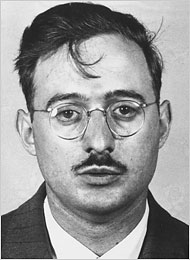Julius Rosenberg (1918-1953) was an American electrical engineer and one of the most infamous Soviet spies of the 20th century.
The son of Polish immigrants, Rosenberg was born on May 12, 1918 in New York City. Politically active from an early age, he participated in City College of New York’s chapter of the Young Communist League. He graduated from City College in 1939 with a degree in electrical engineering. That same year, he married Ethel Greenglass and became a member of the Communist Party.
Spying
In 1940, Rosenberg joined the U.S. Army Signal Corps as a civilian engineer, and later became an inspector. He worked at the Signal Corps Engineering Laboratories at Fort Monmouth, New Jersey. By 1942, he had become involved in espionage for the Soviet Union. Rosenberg left the Communist Party to provide cover for his espionage activities. According to his Soviet handler, Rosenberg provided numerous classified documents, including a model of a proximity fuze. In Soviet cables that were later deciphered by the Venona Project, Rosenberg was codenamed LIBERAL.
Rosenberg was also involved in attempting to recruit others to spy for the Soviet Union, including his brother-in-law David Greenglass, a member of the Special Engineer Detachment at Los Alamos. Greenglass passed details about the Manhattan Project to Rosenberg, including information about the high-explosive lenses being developed for the implosion bomb.
In 1945, Rosenberg was fired from his job at the Signal Corps after his membership in the Communist Party came to light. He worked for the Emerson Radio Corporation and then co-founded the G&R Engineering Company, a machine shop, with Greenglass. In 1950, when the atomic spy ring unraveled with arrests of Klaus Fuchs and Harry Gold, Greenglass implicated Rosenberg. On July 17, 1950, Julius was arrested; Ethel was arrested a month later.
Trial and Execution
Julius and Ethel were convicted of conspiracy to commit espionage on March 29, 1951, and were sentenced to death. Throughout their appeals, the Rosenbergs maintained their innocence. They were executed at Sing Sing prison in New York on June 19, 1953. The trial and execution of the Rosenbergs generated an enormous amount of controversy, both at the time and today. In recent years, new evidence has confirmed that Julius was indeed a Soviet agent.





